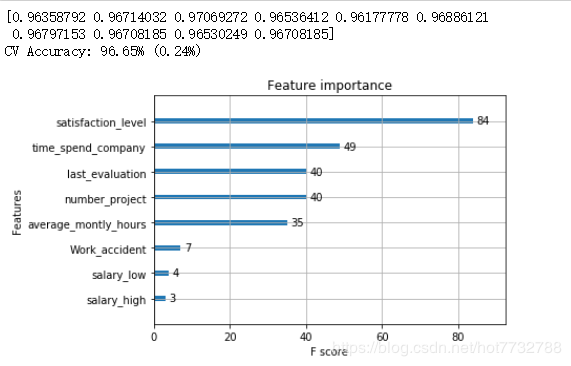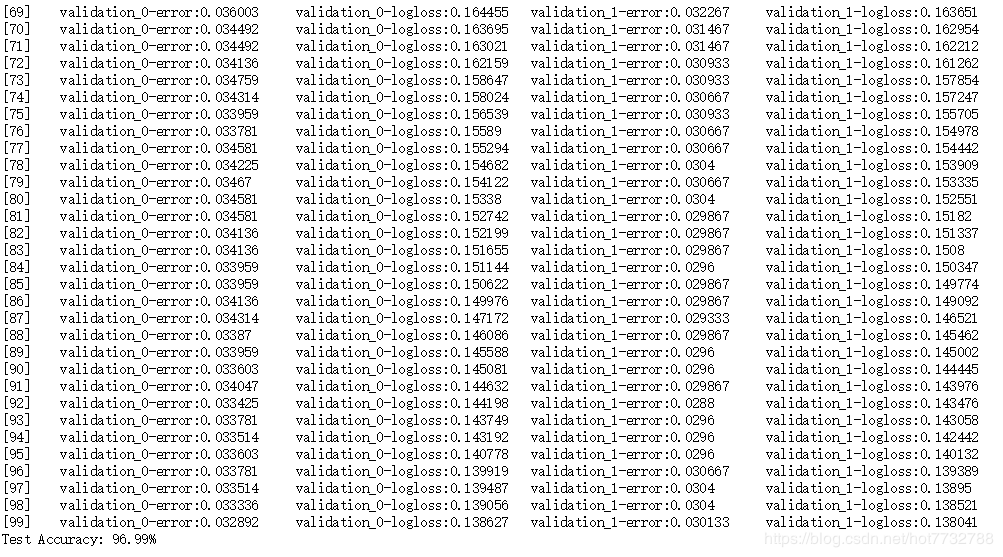1.数据读取
利用原生xgboost库读取libsvm数据
|
1
2
|
import xgboost as xgbdata = xgb.DMatrix(libsvm文件) |
使用sklearn读取libsvm数据
|
1
2
|
from sklearn.datasets import load_svmlight_fileX_train,y_train = load_svmlight_file(libsvm文件) |
使用pandas读取完数据后在转化为标准形式
2.模型训练过程
1.未调参基线模型
使用xgboost原生库进行训练
|
1
2
3
4
5
6
7
8
9
10
11
12
13
14
15
16
|
import xgboost as xgbfrom sklearn.metrics import accuracy_scoredtrain = xgb.DMatrix(f_train, label = l_train)dtest = xgb.DMatrix(f_test, label = l_test)param = {'max_depth':2, 'eta':1, 'silent':0, 'objective':'binary:logistic' }num_round = 2bst = xgb.train(param, dtrain, num_round)train_preds = bst.predict(dtrain)train_predictions = [round(value) for value in train_preds] #进行四舍五入的操作--变成0.1(算是设定阈值的符号函数)train_accuracy = accuracy_score(l_train, train_predictions) #使用sklearn进行比较正确率print ("Train Accuary: %.2f%%" % (train_accuracy * 100.0))from xgboost import plot_importance #显示特征重要性plot_importance(bst)#打印重要程度结果。pyplot.show() |
使用XGBClassifier进行训练
|
1
2
3
4
5
6
7
8
9
10
11
12
13
14
15
16
17
18
19
20
21
22
23
|
# 未设定早停止, 未进行矩阵变换from xgboost import XGBClassifierfrom sklearn.datasets import load_svmlight_file #用于直接读取svmlight文件形式, 否则就需要使用xgboost.DMatrix(文件名)来读取这种格式的文件from sklearn.metrics import accuracy_scorefrom matplotlib import pyplotnum_round = 100bst1 =XGBClassifier(max_depth=2, learning_rate=1, n_estimators=num_round, #弱分类树太少的话取不到更多的特征重要性 silent=True, objective='binary:logistic')bst1.fit(f_train, l_train)train_preds = bst1.predict(f_train)train_accuracy = accuracy_score(l_train, train_preds)print ("Train Accuary: %.2f%%" % (train_accuracy * 100.0))preds = bst1.predict(f_test)test_accuracy = accuracy_score(l_test, preds)print("Test Accuracy: %.2f%%" % (test_accuracy * 100.0))from xgboost import plot_importance #显示特征重要性plot_importance(bst1)#打印重要程度结果。pyplot.show() |
2.两种交叉验证方式
使用cross_val_score进行交叉验证
|
1
2
3
4
5
6
7
8
9
10
11
12
13
14
15
16
17
18
19
|
#利用model_selection进行交叉训练from xgboost import XGBClassifierfrom sklearn.model_selection import StratifiedKFoldfrom sklearn.model_selection import cross_val_scorefrom sklearn.metrics import accuracy_scorefrom matplotlib import pyplotparam = {'max_depth':2, 'eta':1, 'silent':0, 'objective':'binary:logistic' }num_round = 100bst2 =XGBClassifier(max_depth=2, learning_rate=0.1,n_estimators=num_round, silent=True, objective='binary:logistic')bst2.fit(f_train, l_train)kfold = StratifiedKFold(n_splits=10, random_state=7)results = cross_val_score(bst2, f_train, l_train, cv=kfold)#对数据进行十折交叉验证--9份训练,一份测试print(results)print("CV Accuracy: %.2f%% (%.2f%%)" % (results.mean()*100, results.std()*100))from xgboost import plot_importance #显示特征重要性plot_importance(bst2)#打印重要程度结果。pyplot.show() |

使用GridSearchCV进行网格搜索
|
1
2
3
4
5
6
7
8
9
10
11
12
13
14
15
16
17
18
19
20
21
22
|
#使用sklearn中提供的网格搜索进行测试--找出最好参数,并作为默认训练参数from xgboost import XGBClassifierfrom sklearn.model_selection import GridSearchCVfrom sklearn.metrics import accuracy_scorefrom matplotlib import pyplotparams = {'max_depth':2, 'eta':0.1, 'silent':0, 'objective':'binary:logistic' }bst =XGBClassifier(max_depth=2, learning_rate=0.1, silent=True, objective='binary:logistic')param_test = { 'n_estimators': range(1, 51, 1)}clf = GridSearchCV(estimator = bst, param_grid = param_test, scoring='accuracy', cv=5)# 5折交叉验证clf.fit(f_train, l_train) #默认使用最优的参数preds = clf.predict(f_test)test_accuracy = accuracy_score(l_test, preds)print("Test Accuracy of gridsearchcv: %.2f%%" % (test_accuracy * 100.0))clf.cv_results_, clf.best_params_, clf.best_score_ |
3.早停止调参–early_stopping_rounds(查看的是损失是否变化)
|
1
2
3
4
5
6
7
8
9
10
11
12
13
14
15
16
17
|
#进行提早停止的单独实例import xgboost as xgbfrom xgboost import XGBClassifierfrom sklearn.metrics import accuracy_scorefrom matplotlib import pyplotparam = {'max_depth':2, 'eta':1, 'silent':0, 'objective':'binary:logistic' }num_round = 100bst =XGBClassifier(max_depth=2, learning_rate=0.1, n_estimators=num_round, silent=True, objective='binary:logistic')eval_set =[(f_test, l_test)]bst.fit(f_train, l_train, early_stopping_rounds=10, eval_metric="error",eval_set=eval_set, verbose=True) #early_stopping_rounds--当多少次的效果差不多时停止 eval_set--用于显示损失率的数据 verbose--显示错误率的变化过程# make predictionpreds = bst.predict(f_test)test_accuracy = accuracy_score(l_test, preds)print("Test Accuracy: %.2f%%" % (test_accuracy * 100.0)) |
4.多数据观察训练损失
|
1
2
3
4
5
6
7
8
9
10
11
12
13
14
15
|
#多参数顺import xgboost as xgbfrom xgboost import XGBClassifierfrom sklearn.metrics import accuracy_scorefrom matplotlib import pyplotnum_round = 100bst =XGBClassifier(max_depth=2, learning_rate=0.1, n_estimators=num_round, silent=True, objective='binary:logistic')eval_set = [(f_train, l_train), (f_test, l_test)]bst.fit(f_train, l_train, eval_metric=["error", "logloss"], eval_set=eval_set, verbose=True)# make predictionpreds = bst.predict(f_test)test_accuracy = accuracy_score(l_test, preds)print("Test Accuracy: %.2f%%" % (test_accuracy * 100.0)) |

5.模型保存与读取
|
1
2
3
4
5
6
7
8
9
10
11
12
13
14
15
16
|
#模型保存bst.save_model('demo.model')#模型读取与预测modelfile = 'demo.model'# 1bst = xgb.Booster({'nthread':8}, model_file = modelfile)# 2f_test1 = xgb.DMatrix(f_test) #尽量使用xgboost的自己的数据矩阵ypred1 = bst.predict(f_test1)train_predictions = [round(value) for value in ypred1]test_accuracy1 = accuracy_score(l_test, train_predictions)print("Test Accuracy: %.2f%%" % (test_accuracy1 * 100.0)) |
以上就是本文的全部内容,希望对大家的学习有所帮助,也希望大家多多支持服务器之家。
原文链接:https://blog.csdn.net/hot7732788/article/details/90903152










